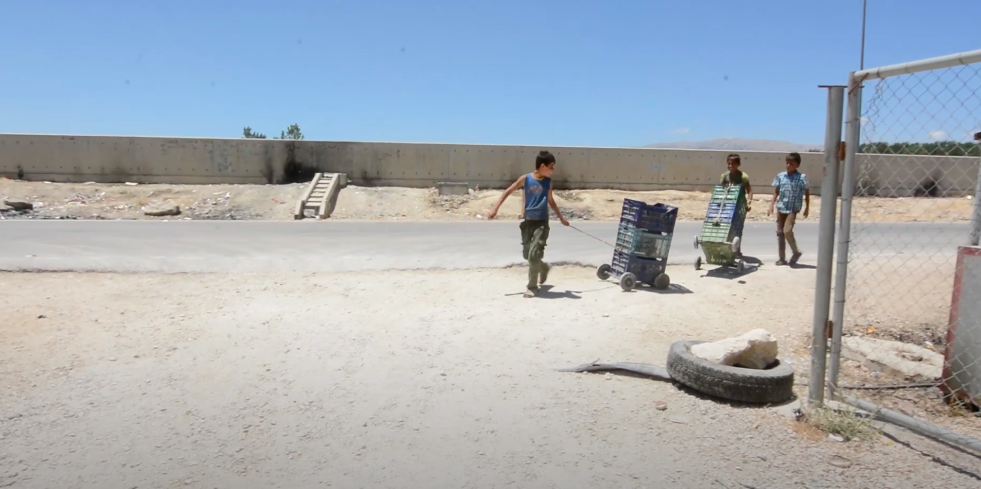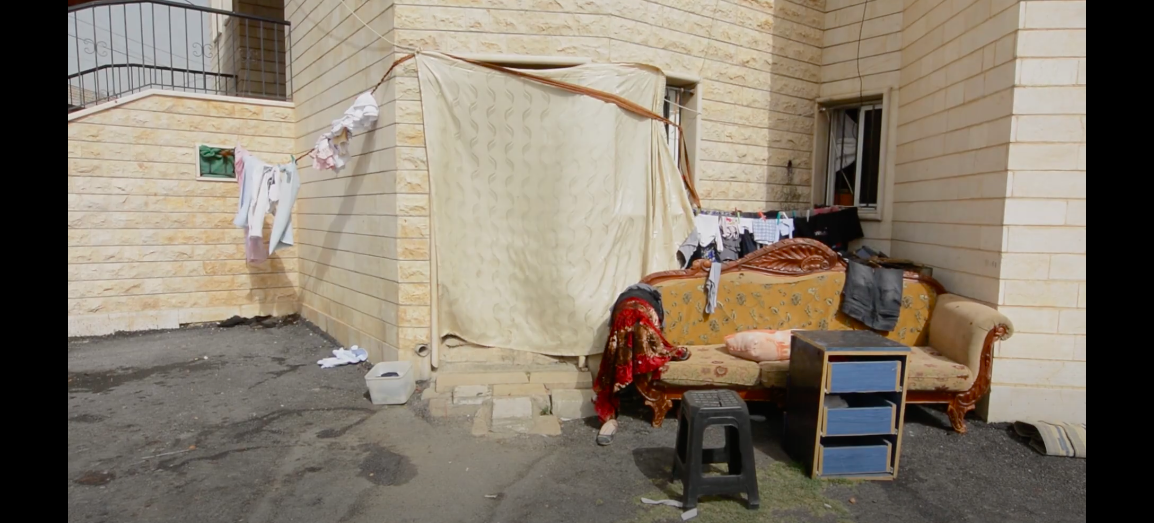RELIEF Mass Displacement Middle East
Dr Hanna Baumann & Hannah Sender
In Lebanon, which has experienced a series of political crises in recent years, refugees and citizens alike have been negatively affected by the dilapidated infrastructure which people rely on in their daily lives. Researchers at the IGP has been thinking about the relationship between infrastructure, displacement and vulnerability, while experimenting with locally-led participatory methodologies. Based on work carried out in the project Public Services and Vulnerability in the Lebanese Context of Large-Scale Displacement and the RELIEF Centre, we were curious to consider the role of film, not only as a means of communicating / disseminating findings, but as a form of research. This is the question we sought to explore through the Project “Addressing Lebanon’s Double Crisis: Film in and as Research”, funded by UCL’s Grand Challenges scheme on Migration and Displacement.
The research site was Bar Elias, a town in Lebanon's Beqaa Valley. Located only a few kilometres from the border with Syria, Bar Elias has historically been a site of exchange between the two countries. Since civil war broke out in Syria in 2011, Bar Elias and the surrounding villages have become temporary homes for displaced Syrians. According to a high-ranking government official in Bar Elias, their arrival doubled the population of the town between 2011-2013, and the UN considers it one of the 'most vulnerable' locations in Lebanon due to the high proportion of refugees. This rapid population change has resulted in a sudden increase in housing demand, more development, informal tented settlements, and has contributed to a pre-existing burden on social and physical infrastructures. Bar Elias’ rapidly changing conditions, the difficulty obtaining reliable datasets, and locals’ frustration about poor delivery of goods and services call for innovative ways of learning about life in the town. Thus, questions about residents' participation in urban development and about the collaboration between hosts and refugees have been at the forefront for our team working here.
Participatory (visual) research
The IGP's partner, not-for-profit design studio CatalyticAction has been working in Bar Elias since 2015. It has used participatory approaches in design research with local residents – from the Lebanese, Syrian and Palestinian communities – to create public space installations, schools and playspaces. Their work has highlighted common vulnerabilities between the different communities, and the importance of common infrastructure to the prosperity of the entire town.
CatalyticAction's participatory spatial methodology complements the IGP's unique Citizen (Social) Science approach. Our Citizen Scientists are much more than enumerators - they help frame the questions asked and play a crucial role in analysing results. Citizen scientists don’t need to be citizens, of course – in fact, in Bar Elias, we wanted to make sure that they represented all the local communities. Therefore, the local researchers recruited by CatalyticAction were Lebanese, Palestinian, and Syrian. The active participation of refugees is essential to the project, which sought to foreground the agency of displaced people and their ability to actively contribute to their host communities. This project therefore combined the two methodologies and took it one step further, by adding film-making as a research method.
Making sure that everybody could participate in all stages of the research was a specific challenge for the researchers. Participatory visual methodologies can allow participant-researchers to voice their own perspective, but also to collectively reflect on the final outputs. Both researchers and audiences come to see problems through the participants’ eyes and thus destabilises common power dynamics between researcher and researched. We saw visual research as a leveller – accessible to everyone, regardless of language, education – whilst recognising that it also requires particular skills.
The Project - Film as Research
We conceived ‘Addressing Lebanon’s 'double crisis': film in & as research’ as an exploration of themes which had emerged in our previous research in Bar Elias. We used participatory video with the local researchers to a) encourage different ways of exploring a town they lived in; and b) to offer a different way of looking at infrastructures and vulnerabilities in Bar Elias to locals and to the international public. Between March and September 2019, we worked with CatalyticAction and Salam Ya Sham, a small cultural and media NGO run by Syrian refugees, to train local researchers from Lebanese, Syrian, Palestinian communities: Asmaa al-Haj Khalil, Amr El Mays, Moayyad Hamdallah, Ali Rheial, Mahdi Homsi. All of them had previously explored the links between Lebanon’s ‘refugee crisis’ and its infrastructural crisis in other projects. The local researchers followed a film-production cycle, incorporating the research skills they had already gained in previous projects. Salam Ya Sham led the film-making training, and CatalyticAction facilitated discussions about narrative and research planning.
Image: Theoretical training in storyboarding, which local researchers then applied in practical exercises © Salam Ya Sham
During the theoretical training, which took place over four days in July 2019, the local researchers considered how to focus on themes appropriate for short documentary films, and how to tailor their films to a specific target audience. They learned about creating a narrative within the film and how main characters shape it. They experimented with storyboarding to implement this narrative, and were taught technical aspects of the filming process, including framing, lighting and sound. After filming for five days, they were involved in the editing process, although Salam Ya Sham’s staff completed most of this rather technical work.
The local researchers chose a research direction which could be said to have foreshadowed the concerns made prominent since the October 2019 protests: they reflected on the importance of basic goods (like housing), common infrastructures (such as waste management), and natural assets, and asked how the failures and fragility of these infrastructures affect the diverse communities of Bar Elias:
‘It was a river’ gives an insight into the gradual pollution of the Litani River and its impact on social life, economic prosperity, and the physical health and wellbeing of residents.

Image: © Salam Ya Sham
‘Waste Journey’ tells the story of two waste sorting processes: the formal, but now suspended, municipal recycling programme and the informal sorting-for-cash process carried out by young refugee children.

Image: © Salam Ya Sham
‘I am here’ shifts the audience’s attention to housing as a common infrastructure. ‘I am here’ is both a strong statement of resistance and determination and one which demonstrates and demands recognition of vulnerability.

Image: © Salam Ya Sham
Local researchers' reflections
In participatory video-making, the final film itself is often not the most important outcome – the process of getting there can be as important, or even more so. In tracking what they learnt in diary entries and writing their reflections after the project ended, the local researchers noted that that they had learned practical new skills. Ali Rheil found he was able to apply critical thinking about social problems to the issues the groups discussed and documented while Moayyad Hamdallah became less nervous about conducting on-camera interviews with some practice. He wrote: ‘this has strengthened my confidence, especially after seeing the final films my colleagues and I made.’ Asmaa al-Haj enjoyed applying the theoretical training in the practical exercises and noted that the issues covered linked not only to the trainings she had taken part in as a Citizen Scientist, but also to her university studies.
When they went out into the world, the local researchers learned new things about their hometown. Here, the camera served as an excuse to go places or speak to people one usually might not approach, and at times elicited unexpected reactions. Amro El Mays wrote in his reflections on the experience: ‘I realised the power of documentary film as a research tool when the director of the waste sorting plant made us wait for half an hour to equip his workers with the right work clothing and masks [health and safety measures which are usually ignored], because he understood the impact the film might have on the audience. This left an impression on me in terms of pursuing the subject, as I believe in the power of research. This was a new experience that I hadn’t known before.’
According to Involve, participatory video projects can serve a number of aims, from scrutinising local problems in order to find solutions to serving as a voice for marginalised groups, or initiating action – whether on the part of communities or policy makers. As the team is keen for local residents to see the outcome of their work, a public screening will be organised in Bar Elias as soon as restrictions due to the Corona virus subside. They hope it will not only showcase the work done, but lead to public discussions about these important issues. As Amro reflected on the power of films to enable social change: ‘Films are a sophisticated way to influence people. It is possible to create a real collective consciousness. I am ready for any new practical experience of this kind, and to learn any techniques that will help me to build a better town.’
Fatemeh Sadeghi
30 May 2024 Feminists in the Global South have stepped out of the conventional territories of ‘women’s matters’ into more fund...